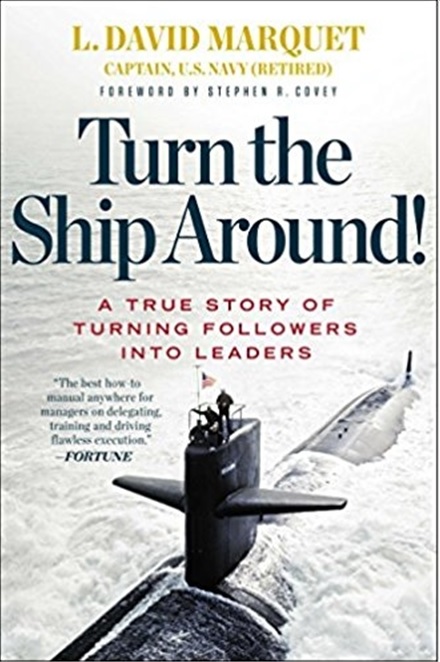Turn the Ship Around! A True Story of Turning Followers Into Leaders by Navy Captain (R) L. David Marquet is an inspirational personal account of Captain Marquet’s experiences while commanding the USS Santa Fe nuclear submarine.
Captain Marquet walked his audience through his organization to emphasize a different approach to leadership. Using a “leader-leader” approach to an organization instead of a “leader-follower” model led to the success of the USS Santa Fe nuclear submarine.
All told, I loved this book. It captures the imagination of a nuclear submarine with a clear-cut vision of what Captain Marquet wanted to say. I’ll start with a summary of the book and end with some takeaways.

Photo by Maël Balland
Summary
Turn the Ship Around begins with Captain Marquet studying to take command of the USS Colombia, the best submarine of the United States Navy. He studied everything from the crew, maintenance records, accident records, training awards, and deployment documents.
Captain Marquet poured over these documents for over a year and felt like he knew the USS Colombia. However, two weeks before he was supposed to take command, he got a call. Instead, Marquet got reassigned to the worst ship in the US submarine fleet: The USS Santa Fe.
When Captain Marquet took command, he began making changes with the middle management: the chiefs. If the chiefs believed in the ‘leader-leader’ approach proposed by Captain Marquet, then the ship could improve.
Morale on the USS Santa Fe was low. Captain Marquet realized that he was part of a “leader-follower” organization, which hindered progress on important tasks. To counter the antiquated model, Captain Marquet created the “leader-leader” model where everyone was a leader.
The USS Santa Fe improved since Captain Marquet implemented the ‘leader-leader’ model.
The book begins six months before their deployment and works its way through the end of the deployment. Captain Marquet talks about issues they encountered, how he solved them, where he went wrong, and what the crew did correctly.
As Captain Marquet began delegating more authority, he found the crew acting more proficiently with proper training.
Key Takeaways
Writing Style
I liked the way Captain Marquet writes his book because he goes into just enough detail without boring the reader. He’ll often give small accounts of an issue then apply that story to a lesson learned.
He’ll ask questions at the end of each chapter to help the reader apply the leadership concept to their workplaces. It was a nice personal touch from a successful commander to his audience. It’s a novel idea, and he implemented it well.
Captain Marquet’s book was a timeline from the beginning of command until deployment, and then afterward. Also, he split his book into three sections to guide the reader on his journey aboard the USS Santa Fe.
The format helped keep the book alive in my mind. He even incorporated some of his previous experiences on the USS Roy Rogers and applied those lessons to his command of the USS Santa Fe.
Leadership Concepts Applied To Life
While listening to the book, I found myself pondering the same questions that Captain Marquet posed. It made the book applicable to my professional life. I’ll give a brief example of a concept he discussed:
When Captain Marquet first came to the USS Santa Fe, he decided to provide minimal orders while in command. He believed that while he was competent, his junior officers and petty officers needed to run their sections.
However, the ‘leader-leader’ model of leadership took a long time to implement effectively. Despite the problems Captain Marquet encountered while using the ‘leader-leader’ model, he found ways to correct those problems and make the USS Santa Fe more effective.
The ‘leader-leader’ model is the epitome of empowering subordinates to accomplish their assigned duties.
We often overuse ’empowering our subordinates’ to mean maximum delegation to allow the ‘leader’ to sit back. However, Captain Marquet’s book didn’t portray this concept. Rather, he emphasized decision-making at the lowest level to those who had the proper information to make an informed decision.
Captain Marquet embodied that principle in this book. He resisted giving direct orders that would derail his crew’s efforts. He took a mentorship approach to his command, which was something I liked.

Photo by Guy Kawasaki
Simple Layout
Each chapter provides a new lesson-learned. Theoretically, I could tear a section out of the book and teach a whole class on it. Some leadership books cram many studies, anecdotes, and personal experiences into each chapter, but not Captain Marquet.
The story-like flow helps readers and listeners to follow along easily. For example, he talked about a docking violation his crew committed while on land. He explained it so well that I understood the violation without knowing proper naval docking procedures.
Buy Turn the Ship Around!
Conclusion
Turn the Ship Around has a unique perspective on leadership. It shows how decentralized leadership can accomplish more than a sole decision maker in a centralized structure. I enjoyed learning about Captain Marquet’s leadership philosophy.
If you want to purchase the book, you can buy it here.
Have you read Turn the Ship Around!? Let me know in the comments below! Thanks for reading!
Photo Credit
Featured Image: Unknown Author is licensed under CC BY-ND
1: Maël Balland
2: Amazon.com
3: Guy Kawasaki






Hello there. Thank you for sharing your unbiased review of Turn The Ship Around by Navy Captain (R) L. David Marquet. I find this book quite interesting considering the fact that I am an aspiring leader and would love to do excellently well as a great leader. I like the way he focused on a particular aspect in each chapter and the fact that this book is not boring. I am very sure it will help refine my leadership skills.
Tush,
I’m glad you enjoyed the review! Good luck in your leadership endeavors and come back here soon!
Robert
Hi,
Your article is fabulous, talks about the book I am about to start reading.
Your review about the ‘Turn The Ship Around’ is helpful as it gives the reader about the glimpse of what to expect without telling too much.
I would like to read more of your articles, especially more book reviews.
Best wishes.
Skamalka,
I’m glad you enjoyed the review! I’m writing more book reviews, so come back to the site any time! Thanks for your comment.
Robert
Hi Robert,
I love reading books on leadership, and this does seem like it could be a good one to read. I too am a student of leadership and it’s great trying to apply leadership principles that we learn at our jobs or on courses etc and try to apply them in real life. Much like you describe with Captain Marquet.
If I buy a copy of this book, I will let you know my thoughts on it and give my own review.
Thank you for sharing and keep up the great work.
All the best,
Tom
Tom,
I’m glad you enjoy reading books on leadership! Let me know what you think of the book when you read it. Thank you for your comment!
Robert